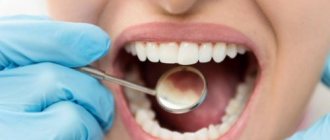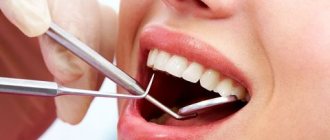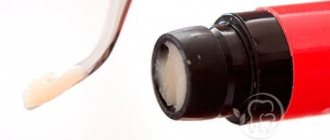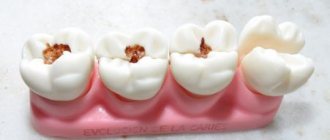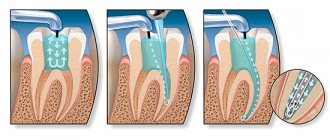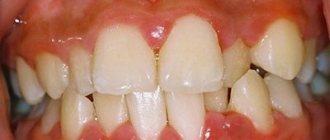What is caries and its 4 stages
Human teeth have a multilayer structure. The inner layer is the pulp, consisting of blood capillaries and nerve endings, followed by dentin, which forms the pulp cavity. The root part of the teeth is covered with cement, the crown part is covered with enamel about 2 mm thick. It protects the inner layers from traumatic external influences. Scientists have found that this is the hardest tissue in the human body. It consists of 97% inorganic substances. But even such a durable fabric can begin to collapse for various reasons (they will be discussed a little later). This process is called caries.
Caries is a dental disease that causes pathological destruction of hard tooth tissues.
The process starts with the enamel. Without treatment, the disease progresses and destroys dentin and reaches the pulp. Its development can be triggered by a number of external and internal factors. Without treatment, it can result in tooth loss and infection of periodontal tissue. According to statistics, this is the most common disease on the planet; more than 93% of the world's population suffered from it. Timely initiation of treatment therapy guarantees a positive result. In its development, caries goes through 4 stages without treatment:
- spot stage – demineralization of a local area of the surface, visually noticeable as a white matte spot. There are no other symptoms;
- superficial phase – destruction of the enamel layer. A reaction to external stimuli appears (hot, cold, sweet, sour);
- medium – the pathological process begins to destroy dentin. Pain is added to the early symptoms;
- deep – the affected area increases, pain becomes constant.
Causes and features of deep caries
The main reason for the development of caries is bacterial plaque that accumulates on tooth enamel, most often in hard-to-reach places. Microorganisms living in these deposits produce acid during their life, which gradually softens and destroys the enamel. The process is accelerated by low resistance of dental tissue to external influences, poor diet, and hereditary predisposition.
Deep dental caries never begins immediately; the process progresses gradually.
First, a whitish or yellowish spot appears on the affected area. Then it darkens, the surface loses its smoothness and shine, becomes rough, and tissue destruction begins. When destructive changes reach the last stage, the deepest layers of dentin are affected. If the thickness of the remaining tissues that separate the carious cavity from the nerve is too small, the tooth reacts to the influence of any irritants with pain.
The last stage of caries without treatment can be complicated by diseases such as pulpitis and periodontitis. When they develop, inaction is fraught with tooth loss, which can only be restored through implantation.
Indications for treatment
You should make an appointment with a doctor if a white spot on the enamel surface becomes noticeable or its color has darkened. This should also be done if a piece of a tooth breaks off or a crack appears on it, or the border of a previously placed filling has darkened. A clear indication is the formation of a carious cavity, the appearance of a reaction to irritants, and pain. You will have to postpone going to the dentist if you have an infectious disease or herpes in the acute phase. Treatment during pregnancy must be agreed upon with the attending obstetrician-gynecologist.
Important: the sooner the patient contacts the dentist, the easier it will be to stop the pathological process. Therefore, a preventive visit to the doctor is no less important than a visit to the doctor when symptoms appear.
Prevention
Deep caries can be prevented if:
- Visit your dentist every six months for a preventative oral examination.
- Treat superficial and medium caries in a timely manner, even if there is no pain.
- Brush your teeth regularly, following the rules for this hygiene procedure.
- Get enough calcium, other minerals and vitamins.
- Limit sugar, starch, sweet and flour foods in your diet.
All these measures will help not to miss the disease, prevent the formation of plaques on the teeth and increase the body’s resistance to caries. For prevention, it is also important to lead a healthy lifestyle and promptly neutralize acute infections.
Methods used to treat the disease at different stages
Varying degrees of damage to dental tissue dictate the need for an individual approach in each specific case. So, at the white spot stage, it is necessary either to mineralize the enamel to restore it, or to remove the stain using a minimally invasive infiltration method without affecting healthy tissue. If necrotic substances are present, they must be carefully removed, the cleaned surface must be treated with an antiseptic and a seal must be placed. If the pathology has led to significant destruction of the dental unit, then in addition to the described actions it will be necessary to restore the shape of the tooth. This is done using the method of restoration or dentures.
Types and classification
Forks of deep caries according to the location of the defect:
- Fissure. The lesion affects the grooves and natural grooves on the chewing surfaces of the teeth and spreads deeper.
- Approximal (contact). The area on the side of the tooth that is in contact with the adjacent unit is destroyed.
- Cervical. Caries develops near the gums, near the root collar.
Deep caries can have two forms - acute and chronic. They are characterized by different widths of the inlet and the base of the cavity.
Protocol for classical treatment of deep caries
- Diagnosis of the degree of tissue damage (including using x-rays)
- Performing local anesthesia
- Drilling out the affected dentin, giving the cavity a geometric shape (if pulp damage is detected, depulpation will be performed)
- Antiseptic treatment
- Adding calcium preparation
- Installing a temporary filling
- After 2–3 days, remove the temporary filling; if the condition of the cavity is satisfactory, fix the permanent filling
- Sanding and polishing
Note: specialists from the “Smile” clinic network have extensive practical experience in caries treatment. The use of modern equipment allows us to provide assistance to patients in clinical situations of any severity.
Diagnosis and treatment
To diagnose deep caries, the dentist uses the following methods:
- Patient interview. The specialist is interested in complaints and the duration of the manifestation of pathological symptoms.
- Examination of the oral cavity and diseased tooth. The doctor visually examines the affected area, identifying significant tissue destruction or the presence of a small external defect.
- Probing. A dental probe helps determine whether the floor of the cavity is sensitive or painless.
- Thermometry. Using this method, the tooth's reaction to temperature stimuli is checked.
To clarify the diagnosis, EDI (electroodontodiagnosis) and radiography may be needed.
High-quality treatment of deep caries consists of eliminating the infection, removing destroyed tissue and filling the cleaned cavity. All manipulations are carried out under reliable anesthesia. One appointment may not be enough to complete the therapeutic process. A second visit is required if the doctor doubts that the pulp is not infected. In this case, after treating and cleaning the cavity, the dentist installs a temporary restorative filling. If the tooth does not bother the patient for several days and does not react to temperature stimuli, then during the second visit the doctor places a permanent filling. Then he grinds and polishes the surface, giving it an anatomical shape.
How to care for treated teeth
Dentists advise not to eat for a couple of hours after installing a permanent filling (residual effects of anesthesia can cause injury to the oral mucosa). During the day, do not apply increased pressure to the sealed area, i.e. do not chew nuts and other particularly hard foods. It is possible that the filling will cause slight discomfort. If it does not go away within a week, you should contact your dentist to correct the shape of the filling. Dental care after visiting the clinic is the same as usual: brushing your teeth twice a day, rinsing your mouth after eating and drinking sugary drinks.
The dental network offers services for the diagnosis and effective treatment of dental caries at any stage of its development. Contacting our branches has significant advantages:
- treatment by highly qualified doctors;
- compliance with treatment protocols that meet international standards;
- family and savings discounts;
- stable cost of services;
- Convenient daily work schedule.
You can contact any of the branches of our clinic in Moscow, located within walking distance from metro stations:
- Art. Alekseevskaya (VDNKh district, etc. Mira), address: st. 3rd Mytishchiskaya house 3, building 2;
- Art. Shelepikha, address: Shelepikhinskaya embankment, address: building 34, building 1.
Modern technologies and techniques used in our clinic make each stage of treatment effective. The high qualifications of our specialists serve as a guarantee of quality and safety. The health of your teeth is in good hands!
Caries
3802 16 August
IMPORTANT!
The information in this section cannot be used for self-diagnosis and self-treatment.
In case of pain or other exacerbation of the disease, diagnostic tests should be prescribed only by the attending physician. To make a diagnosis and properly prescribe treatment, you should contact your doctor. Caries: causes, symptoms, diagnosis and treatment methods.
Definition
Caries is an infectious lesion of the teeth in which demineralization and softening of the hard tissues of the tooth occurs with the formation of a defect in the form of a cavity. This is the most common disease of the dental system. Caries occurs among all age groups, but more often among adults over 35 years of age, where it accounts for 98-99%.
Causes of caries
In the oral cavity of any person there live a large number of microorganisms that are in balance and actively interact with the human body and with each other. This balance may change briefly under the influence of various factors, for example, after a teeth whitening procedure, but then the balance is restored again. If the body's defenses are reduced, the changes can be more significant and lasting.
Various bacteria, fungi and protozoa live on the oral mucosa, in the ducts of the salivary glands and in saliva, in gingival fluid and oral fluid, but most of them live in dental plaque - up to 90% of all microflora.
Dental plaque is a soft sticky deposit on the surface of teeth containing a large number of microorganisms, their metabolic products, epithelial cells, leukocytes, proteins and lipids of saliva. The formation of dental plaque is a natural process, and in the absence of timely and thorough dental care, it forms within 1-2 days. As a result of structural changes in plaque, dental plaques form quite quickly. Bacteria present in dental plaque and plaques actively “exchange information”, build a large number of connections, and then stick together, forming a microbial biofilm. In a biofilm, microorganisms exchange genetic material, nutrients, and remove metabolic products. The creation of such a biofilm protects bacteria from the body's defense cells and from the action of antibiotics. As a result of the vital activity of microbial biofilm, a large amount of organic acids is formed, under the influence of which demineralization of tooth enamel begins. Small defects form, microorganisms penetrate there, destroying the enamel further, resulting in the formation of a cavity in the tooth - caries.
Carbohydrates serve as food for microorganisms, so eating sweet foods contributes to the development of caries.
In addition, predisposing factors are a decrease in the body's defenses, smoking, poor oral hygiene, and taking antibiotics - all this leads to an imbalance in the oral microflora, resulting in the proliferation of streptococci and lactobacilli, which are responsible for the production of organic acids and the development of caries.
Classification of caries
Doctors classify caries depending on the stage and location of the lesion. The stage of initial caries, in which the process does not extend beyond the enamel-dentin boundary, is called the white or chalky spot stage. This is followed by the stage of dentin caries, in which the disease crosses the enamel-dentin boundary without affecting the pulp, and the stage of cement caries with damage to the exposed surface of the tooth root in the cervical region.
Focal demineralization of enamel is characterized by the appearance of a dark pigmented spot within the enamel and is called the stage of suspended caries.
Based on the location of the cavities, there are 6 classes of the disease:
Class I - cavities localized in the area of grooves on the chewing surface of the teeth (fissures) and natural recesses of the incisors, canines, molars and premolars.
Class II - cavities located on the contact surface of molars and premolars.
Class III - cavities located on the contact surface of the incisors and canines without breaking the cutting edge.
Class IV - cavities located on the contact surface of the incisors and canines with a violation of the angle of the crown of the tooth and its cutting edge.
Class V - cavities located in the cervical region of all groups of teeth.
Class VI - cavities located on the cusps of molars and premolars and the cutting edges of incisors and canines.
Symptoms of caries
Symptoms of the disease depend on its stage. A sign of initial caries is a change in the color of the tooth enamel in a limited area and the appearance of a chalky or gray stain, lacking shine - a focus of demineralization. Then an enamel defect develops, and then a cavity. Patients with caries at the stage of cavity formation note increased sensitivity of the tooth to chemical, temperature and mechanical irritants, while the painful sensations disappear immediately after the irritant is eliminated. A defect can be seen on the visible surface of the teeth.
Further, tooth damage spreads to the underlying tissues - to the upper layers of dentin, after which, in the absence of treatment, the process captures the deep layers of dentin and approaches the pulp - soft connective tissue penetrated by blood vessels and nerve plexuses. At this stage, patients also note increased sensitivity to irritants and pain during chewing.
When the dental pulp becomes inflamed – pulpitis – severe toothache begins. If the disease is not treated, the pathological process can spread beyond the tooth into the bone tissue and periodontitis will develop.
Diagnosis of caries
To make a diagnosis, the doctor examines the oral cavity, examining the mucous membrane, establishes the presence of fillings and the degree of their adherence, the presence of defects in the hard tissues of the teeth, and notes the number of teeth removed. The dentist carefully evaluates the condition of all teeth, determines the density of hard tissues, texture and degree of surface uniformity, checks pain sensitivity, and probes the identified carious cavity. If indicated, radiography is performed.
Which doctors should I contact?
Dentists treat caries.
Treatment of caries
The main goals of caries treatment are to stop the pathological process, restore the shape and function of the affected tooth, prevent the development of complications and restore the aesthetics of the dentition. If the carious lesion is limited to the enamel, then patients may be prescribed deep fluoridation of the hard tissues of the tooth to prevent further development of the process.
If a defect occurs in the hard tissues of the tooth, conservative remineralizing treatment does not have an effect; in this case, the altered tissues are removed and the tooth crown is restored using a filling.
Complications of caries
In almost half of patients aged 35-44 years, there is a need for filling and prosthetics of the affected tooth, and doctors have to resort to tooth extraction in almost a quarter of cases. With late treatment of caries, the pathological process can spread deeper into the dental pulp, and from the infected pulp, inflammation through the tooth canal penetrates further into the bone and under the periosteum of the jaw with the development of inflammation of the periosteum - periostitis or gumboil. Tooth extraction as a result of untimely treatment, which leads to complications, causes deformation of the dentition and can even lead to pathology of the temporomandibular joint.
Dental caries can cause problems with chewing function.
Prevention of caries
To effectively prevent the development of caries, it is necessary, firstly, to prevent the creation in the oral cavity of conditions conducive to the emergence of microbial films and the carious process, and secondly, to increase the caries resistance of dental tissues. The main methods of prevention are regular oral care with proper brushing technology, the use of dental floss, the use of fluoride toothpastes, mouth rinses, reducing sugar consumption and regular dental examinations (once every 6 months).
Sources:
- Clinical recommendations (treatment protocols) for the diagnosis of “Dental caries” Approved by Resolution No. 15 of the Council of the Association of Public Associations “Dental Association of Russia” dated September 30, 2014, updated on August 2, 2022.
- A.I. Khavkin, Yu.A. Ippolitov, E.O. Aleshina, O.N. Komarova. Oral microbiota: protective or pathogenic factor? // Issues of practical pediatrics. – 2015. – T. 10. – No. 4. – P. 49-54.
IMPORTANT!
The information in this section cannot be used for self-diagnosis and self-treatment. In case of pain or other exacerbation of the disease, diagnostic tests should be prescribed only by the attending physician. To make a diagnosis and properly prescribe treatment, you should contact your doctor.
Stages of caries treatment
The main stages include:
- Plaque is removed from the enamel. This is done with ultrasonic attachments, pastes with an abrasive composition, and dental brushes. A special color scale is used when the dentist determines the color of the teeth and selects the appropriate shade of the filling material so that the filling is as invisible as possible on the teeth.
- Opening of the cavity of a tooth affected by inflammation. The edges of the enamel are drilled and the affected dentin is removed. This treatment procedure must be carried out efficiently and professionally. Due to poorly removed areas affected by inflammation, secondary caries may appear;
- Removal of affected tissue. To do this, special devices are used or done manually;
- A cavity is created, which is subsequently filled;
- Treated with antiseptic agents;
- The filling is installed in the place that was prepared for it. Using filling materials, the natural shape of the crown is restored. The filling is fixed with a polymerization lamp. When the filling hardens, the dentist polishes the surface to eliminate irregularities and create anatomical shapes.
Treatments to relieve suffering
In advanced cases, specific individual techniques are used.
- Anesthesia. It is necessary. The dentin located near the pulp is especially sensitive, so when working with the tooth, pain may occur.
- The affected tissue is removed accompanied by cooled air and water. This is necessary to reduce the likelihood of overheating the tooth surface.
- Anti-inflammatory pads and pastes are used. This is necessary to strengthen the internal tooth tissues located above the pulp, remove bacteria, preventing the development of complications.
Deep chronic caries
The chronic form is characterized by a slower course: demineralization of the tooth occurs gradually, which inhibits destruction. In addition, the processes occurring during fissure caries cause blockage of the dentinal tubules, which makes the dentin less permeable to infection. As a result, pulp irritation also decreases, as a result of which pain in chronic caries is less pronounced and acute. Inflammation may not affect the nerve for a long time, since the inside of the pulp chamber is covered with replacement secondary dentin. Sensitivity to temperature influences is also less pronounced.
Despite this, chronic deep caries can be no less, or even more dangerous, than acute caries. Since the process often occurs with minor or no symptoms, by the time you contact a doctor, it sometimes manages to destroy a significant part of the tooth. Under unfavorable circumstances, inflammation can also affect the tissue surrounding the tooth. The long course of chronic caries often leads to the appearance of a specific unpleasant odor from the mouth.

